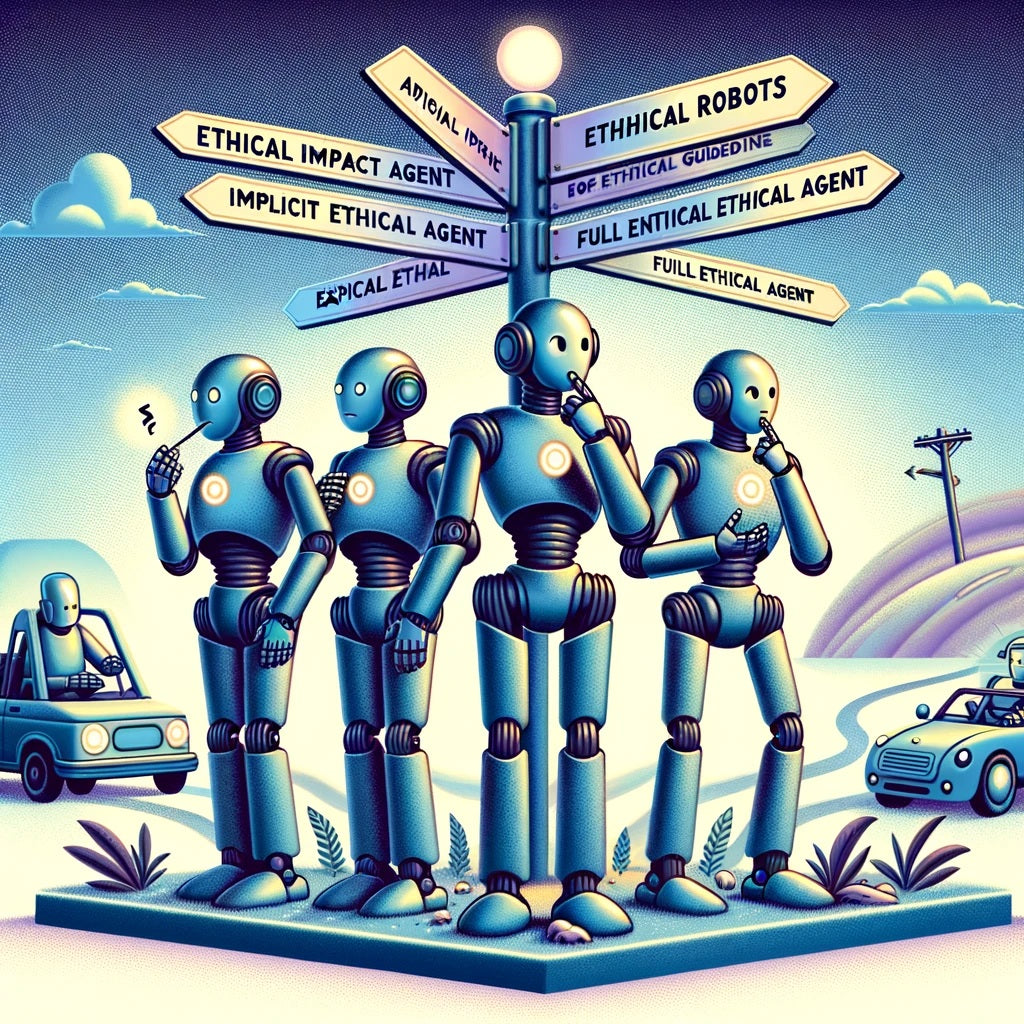Assessments
Types of Ethical Agents: Understanding James H. Moor's Categorization
In the realm of ethical robotics and artificial intelligence, James H. Moor's categorization of ethical agents provides a comprehensive framework for understanding how robots can adhere to ethical standards.
His classification includes ethical impact agents, implicit ethical agents, explicit ethical agents, and full ethical agents.
Ethical Impact Agents
These are robots or AI systems whose actions have ethical consequences, regardless of whether they possess the ability to make ethical decisions.
They perform tasks that impact society and individuals, raising questions about their design, control, and the intentions of their creators.
Ethical Impact Agents are basic robotic systems whose actions have significant ethical implications.
They don't make ethical decisions but are designed to perform tasks with visible ethical impacts.
Implicit Ethical Agents
Implicit ethical agents are programmed with certain ethical constraints or virtues. These constraints guide their operations within predefined ethical parameters.
They don't make ethical decisions but operate within a safe and ethical framework set by their designers.
Explicit Ethical Agents
These agents go a step further by actively making ethical decisions.
They are equipped with the capability to assess situations and determine the best course of action based on ethical principles.
This category reflects a significant advancement in AI, where machines are not just following instructions but making judgements based on ethical considerations.
Explicit Ethical Agents represent a more advanced form of ethical AI.
They actively engage in making ethical decisions, evaluating and choosing between different actions based on ethical considerations.
Implicit Ethical Agents possess built-in ethical guidelines that subtly influence their operations.
They don't engage in ethical reasoning but follow a set of pre-programmed ethical norms.
Full Ethical Agents
Full ethical agents possess qualities similar to human ethical reasoning.
They understand and interpret ethical principles, have consciousness, and make autonomous ethical decisions.
This category represents the pinnacle of ethical AI, where machines can functionally replicate human ethical reasoning and decision-making processes.
They not only make ethical decisions but also possess a level of consciousness and understanding that mirrors human ethical reasoning.
Full Ethical Agents are the pinnacle of ethical AI.
The Evolution and Challenges
As we progress from ethical impact agents to full ethical agents, the complexity and the ethical implications of AI systems increase.
Each category presents its unique set of challenges, ranging from ensuring safety and reliability in ethical impact agents to the complex task of programming explicit ethical principles in full ethical agents.
This categorization by James H. Moor is crucial in guiding the development and governance of AI systems.
As these systems become more integrated into our daily lives, understanding and applying these ethical categories will be key to ensuring that they serve humanity ethically and responsibly.
This categorization underscores the evolving complexity of AI ethics, highlighting the need for rigorous standards and frameworks to guide the ethical development of AI systems.
Analysis
Agreement Points
-
Title: The Necessity of Ethical Impact Agents
Analysis: Ethical Impact Agents are crucial for automating tasks with ethical implications, like in healthcare or environmental monitoring.
Agreement: 90% -
Title: Implicit Ethics for Basic AI Safety
Analysis: Embedding basic ethical guidelines in AI systems is essential for ensuring safety and reliability in their operations.
Agreement: 85% -
Title: Significance of Explicit Ethical Decision-Making
Analysis: The ability of AI to make explicit ethical decisions is pivotal in complex scenarios, such as autonomous vehicles.
Agreement: 95%

-
Title: Advancing Towards Full Ethical Agents
Analysis: The development of Full Ethical Agents, mirroring human ethical reasoning, could revolutionize AI's role in society.
Agreement: 80% -
Title: Ethical AI in Human-Like Roles
Analysis: Full Ethical Agents could effectively function in roles requiring complex ethical judgments, such as counseling or legal advice.
Agreement: 70%
Disagreement Points
-
Title: Ethical Complexity Overload
Analysis: The idea of Full Ethical Agents may be too ambitious, risking ethical complexity that AI may not be able to handle adequately.
Disagreement: 60% -
Title: Overreliance on AI Ethics
Analysis: Heavy dependence on AI for ethical decision-making might erode human ethical judgment and responsibility.
Disagreement: 50% -
Title: Feasibility of Implicit Ethical Agents
Analysis: The concept of Implicit Ethical Agents might be underestimating the complexity of encoding ethics into AI systems.
Disagreement: 40%
Discovery:
- Ethical AI Governance Framework: Developing a comprehensive governance framework for ethical AI is crucial. This framework could include guidelines for transparency, accountability, and ethical audits.
- Human-AI Ethical Collaboration: Integrating human oversight in AI's ethical decision-making process can provide a balanced approach, leveraging the strengths of both human judgment and AI's analytical capabilities.
- Ethical Training for AI Developers: Implementing mandatory ethical training for AI developers and engineers could help in embedding deeper ethical considerations in the AI design process.
These discoveries aim to enhance the ethical development of AI systems, ensuring they are aligned with human values and societal norms.
References
-
Paweł, P., & Krzanowski, R. (2020). Phronetic Ethics in Social Robotics: A New Approach to Building Ethical Robots. Studies in Logic, Grammar and Rhetoric.
-
Vanderelst, D., & Winfield, A. (2018). An architecture for ethical robots inspired by the simulation theory of cognition. Cognitive Systems Research.
-
Koh, W. Q., Vandemeulebroucke, T., Gastmans, C., Miranda, R., & Van den Block, L. (2023). The ethics of pet robots in dementia care settings: Care professionals’ and organisational leaders’ ethical intuitions. Frontiers in Psychiatry.
-
Hua, M. T., Langås, E. F., Zafar, M. H., & Sanfilippo, F. (2023). From Rigid to Hybrid/Soft Robots: Exploration of Ethical and Philosophical Aspects in Shifting from Caged Robots to Human-Robot Teaming. 2023 IEEE Symposium Series on Computational Intelligence (SSCI).
-
Vanderelst, D., & Winfield, A. (2016). The Dark Side of Ethical Robots. Proceedings of the 2018 AAAI/ACM Conference on AI, Ethics, and Society.
These references provide a comprehensive overview of the ethical considerations and advancements in the field of robotics and AI, particularly emphasizing the various types of ethical agents as conceptualized by James H. Moor.

